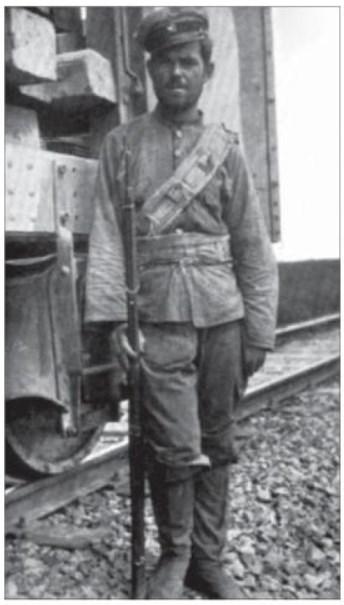1927: a White Russian crewman of the Northern Warlords Army armoured train ‘Shantung’. He is wearing exactly the same uniform as his Chinese comrades, and, unlike White Russians serving in other armies, has no distinguishing insignia of nationality. (This train would later be captured by the NRA, and served in their 4th Armoured Train Battalion before being captured yet again by the Japanese in Manchuria in 1931.)
Many warlords employed foreign advisors to help them train their troops, with the largest contingents coming from Japan and Russia. The Japanese advisors were in most cases spying for their country while serving in the warlord armies. In their main region of interest, Chang Tso-lin had a number of high-ranking Japanese on his staff, including 11 of lieutenant-colonel rank as well as a specialist instructor and two liaison officers. In February 1927 a group of 15 British officers (presumably strongly anti-Communist) were reported to have offered their services to Chang free of charge.
In the mid-1920s Feng Yu-hsiang, the ‘Christian Warlord’, was in receipt of relatively large amounts of Soviet arms as the Russians tried to bribe him to back the Nationalists. These supplies were followed by a Soviet military training mission sent at Feng’s request, although it never nearly reached the 200 personnel that he had initially asked for. The 36 to 50 advisors who did reach his HQ in the city of Kalgan north-west of Peking supervised the construction of several armoured trains and armoured cars. Feng also had a German and an Italian advisor, as well as a Japanese officer named Matsumuro Takayoshi.
China before and during the 1920s was full of colourful foreigners, and one of these was Morris Abraham ‘Two-Gun’ Cohen. Cohen had been a supporter of Sun Yat-sen in his homeland of Canada after a chance meeting with the Chinese revolutionary leader. In 1922 he travelled to China and joined Sun’s entourage as a bodyguard, acquiring his nickname from his habit of always carrying two revolvers. He had taught himself to shoot well with both his left and right hands when he had almost been killed in an ambush. On Sun’s death in 1925, Cohen was granted a pension, and he stayed in China until captured by the Japanese in Hong Kong in 1941.
The most famous non-Russian advisor in Warlord China was undoubtedly Frank ‘One-Armed’ Sutton, an English adventurer who reportedly had lost his arm at Gallipoli in 1915. After 1918 he bought the licence for selling the Stokes mortar in the Far East, and in the early 1920s he hawked his adapted version around the capitals of various Chinese warlords. After working for a Szechwan warlord for several years (and barely escaping with his life), Sutton tried to sell his mortars to Wu Pei-fu. When Wu turned him down he ended up at the HQ of the Manchurian warlord Chang Tso-lin, who took a liking to Sutton; he put him in charge of the Mukden arsenal, which manufactured 400 mortars in its first year of production. Sutton also trained a few thousand men to use the mortars, and would claim that his weapons were largely responsible for Chang’s victory in the Second Chihli-Fengtien War of 1924.
White Russian mercenaries
Large numbers of émigré White Russians fought in China for several of the Northern Warlords during the 1920s. Many of these desperate men and their families had only narrowly escaped from the Russian Revolution and needed to find employment, and former Tsarist soldiers found themselves fighting for warlords in technical roles such as serving artillery or manning armoured trains. Chang T’sung-chang, ‘the DogMeat General’ of Shantung, was one of the most prominent employers of White Russians, with some 3,000 ‘White Guards’ in his service under the command of the Menshikov brothers; the warlord trusted these mercenaries enough to have a personal bodyguard made up of tough Cossack veterans. Uncharacteristically, the brutal ‘Dog-Meat General’ decided to try to improve his soldiers’ morale by recruiting a so-called ‘regiment of nurses’ made up entirely of White Russian women; these were employed to nurse his wounded soldiers, while at the same time training Chinese women to take over from them.
A so-called ‘Foreign Legion’ made up of three nationalities fought for Chang Tso-lin during the Second Chihli-Fengtien War of 1924, under the command of a White Russian general named Netchaieff. The Legion was made up of 700 White Russians, 300 Japanese and two companies of Chinese soldiers; it was divided into two units, with one large White Russian and Chinese element officered by Russians, and a smaller Japanese battalion with its own officers. Even the weaponry used by the Legion was segregated, with the Russians armed with ex-Russian Imperial Army rifles and machine guns and the Japanese having their own small arms. While the Japanese wing was short-lived, being disbanded in November 1924, the White Russians served on for several more years.
Three former Imperial Russian Army generals also worked for the ‘Christian Warlord’ Feng Yu-hsiang, two in the Kaifeng Mission and one at his headquarters at Kalgan.
